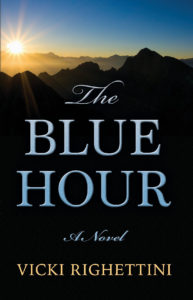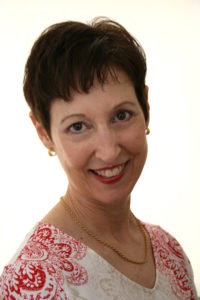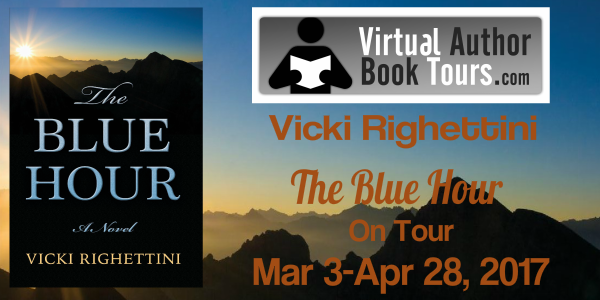 Blue Hour by Vicki Righettini
Blue Hour by Vicki Righettini
Publisher: Mill City Press (Nov 17, 2015)
Category: Historical Fiction, Romance, Pioneer Woman, Strong Female Character, Western
Tour date Mar/Apr, 2017
ISBN: 978-1634138291
Available in Print & ebook, 560 pages
Description of Blue Hour by Vicki Righettini
IN THIS EPIC TALE of love, loss, and redemption, the year is 1861, a time when women are expected to be married by a certain age. At 26, spinster Emily Wainwright has no reason to believe her sheltered life will ever change—until the charming Samuel Todd unexpectedly crosses her path.
Samuel yearns to homestead and start a family in Oregon, but he first needs to find a wife. Blinded by Samuel’s good looks, and grasping at her final chance to have a husband and children, Emily accepts his marriage proposal. However, Samuel is not the man she thought he was, and her marriage becomes a cold, cruel prison, offering her no solace amidst the hardships of farm life.
When Samuel dies and a second chance at love and happiness arrives in the form of farmhand Cole Walker, Emily must overcome her bitter past—or risk losing Cole and the life she has always dreamed of having.
Praise for Blue Hour by Vicki Righettini
“All of Righettini’s characters are well-rounded, in particular Emily herself, whose personal growth throughout the novel is richly detailed and memorable.”-Historical Novel Society
“This novel is about second chances and the courage needed to take them. The most compelling aspects of The Blue Hour are not the vivid, expansive descriptions of life on the vast (and seemingly never-ending) Oregon Trail or the well-drawn characters who dance (and often trudge) between hardship and hope. Instead, the brightest lights burst forth from nuanced moments tucked throughout the story.
Read this book if you want to immerse yourself in the wilds of western America in the 1860s or get lost in the even denser wilderness of love and loss. Maybe this recommendation needs to be simplified even further – read this book. It’s exhilarating to root for a character who is trying to navigate uncharted territory and make the greatest discovery of all.”-Underground Book Reviews
“The Blue Hour is one of the finest historical novels I’ve ever read. You will love the author’s writing and the detailed historical references. The characters are vividly portrayed, and I felt as if I knew them well. Long after I’d finished reading, I still thought about the story. It’s part adventure, part love story, and part survival. Highly recommended.”-Ann Creel, Author
Interview with Vicki Righettini
1- Which character do you love to hate?
It would have to be Samuel Todd. Despite the fact that he is thoroughly despicable, or maybe because of it, I enjoyed being inside his head, hearing his thoughts, seeing the way his mind worked. It reminded me of times I’ve played unlikeable or villainous characters onstage – the audience may hate them, but you as an actor don’t have that luxury. To create a multi-dimensional character, you have to understand and justify their choices, no matter how heinous, and that creates a sympathy with the character you can’t get watching from the outside. If readers dislike or even hate Samuel, I’ve done my job as a storyteller, but I also hope they see a glimmer of decency in him, however faint. It was sad for me when he’d served his purpose in the story and it was time to let him go. Simply put, villains are fun to write.
2- Where did you get the names for your characters in The Blue Hour?
Emily is named after my maternal great-grandmother, who lived to the age of ninety-six; I was lucky to have her in my life until my mid-20s. Emily was supposed to be my name, too. As the story goes, the whole time my mother was pregnant with me, it was “Emily, Emily, Emily.” But when I was born and the maternity nurse asked her what she planned to name me, without missing a beat she said: “Vicki.” She never explained why.
Andrew was the name of my father’s older brother. My mother wanted to name my younger brother after him, but my Italian grandmother insisted it was bad luck to name a baby after someone who was killed in WWII. So Mom named my brother David. (Just think, we could have been Em and Andy.) Norman is the first name of my maternal great-grandfather (Emily’s husband). I decided to use it for Andrew’s surname.
I’ve always believed I chose Samuel’s name at random, but have since changed my mind about that. Samuel’s character is a composite of three men I have known, but he’s largely based on my father, who had an identical twin named, you guessed it: Samuel. The two were so identical that as a kid I couldn’t tell them apart. I think perhaps my subconscious mind was at work when I chose Samuel’s name.
3- How much time and effort went into your research for the book?
In some respects, I’ve been researching this book all my life. As a child I was fascinated by the Western Expansion and the pioneers. I also come from a pioneering family: my mother’s side came to Pennsylvania from Germany in the 1700s; then moved to Kentucky and Illinois in the 1800s; then in the 1940s my mother and grandmother came to California, where I was born. I always imagined I’d have been one of those hardy pioneers, but after researching the book, I’m no longer so sure!
When I started the book in 2001, I wrote the prologue and the first couple of chapters before doing any formal research. Once I realized I had a story, I knew I had to put it into historical context, and to get my facts right. I began by visiting the End of the Oregon Trail Museum in Oregon City, where at the time there was a wonderful exhibit on childbirth practices of the era, home building, and details of daily life. I took copious notes and came home with a stack of books from their bookstore, including maps of the Oregon Trail, 1860s cookbooks, and books on Victorian era customs and style of dress. I also raided local bookstores for herbalism manuals, 19th century poetry, and more books about the Trail. My great-aunt also shared a journal from a family member who lived back then, which gave me a feel for the daily life and speech style of the period.
In all, I spent about six months poring over these materials and cataloging my notes, then about a year finishing the first draft and doing bits of additional research as questions arose. (For example, I wanted Samuel and Emily to celebrate Thanksgiving in Oregon, until my research showed that it wasn’t a national holiday until much later.)
During revisions I was aware that the second part didn’t adequately portray the hardship and sacrifice of the journey. Frankly, it sounded no more difficult than driving cross-country in a car without air-conditioning. So, I spent another year researching and rewriting that section until I was satisfied. Together, the writing, research, and revisions took about seven years from start to finish (not counting the eight years the first draft sat in a drawer, waiting for me to gather the courage to work on it). I was still fact-checking right up until publication, certain that some expert on the Oregon Trail would nail me on some tiny detail. It hasn’t happened yet, but…
4- Tell us about your cover. Did you design it yourself?
The cover was a joint effort between the designer at the publisher and myself. I knew I didn’t want covered wagons, women in gingham and bonnets, or cabins in the distance with tendrils of chimney smoke. In other words, no pioneer clichés. I was advised that omitting these images might confuse potential readers, but I felt strongly that Emily’s story is universal enough to appeal to a wider readership than just fans of pioneer tales.
It was challenging, however, getting the designer to deliver what I did want; not because he didn’t understand, but because it’s impossibly hard to describe a vision. It’s like trying to describe music, or flavor, or scent. He delivered some great artwork, just not what I envisioned.
So I took the bull by the horns and spent hours scouring the internet until I found the perfect image. Once the designer had that in hand, the rest was easy. I love the cover and think he did a terrific job. And the argument that it would confuse readers? I’ve had more people tell me they were drawn to the book precisely because of the beautiful cover. A picture really is worth a thousand words.
5- What are you currently working on?
Several readers have asked for a sequel to The Blue Hour, and it thrills me that they care deeply about the characters and want more. I made a stab at it, and have about forty manuscript pages, but the story wasn’t grabbing me. If I’m going to spend five or so years working on a book, it has to be something I’m obsessed with. Also, in writing The Blue Hour, I set many family and personal issues to rest. Now that I’ve done battle with those ghosts, I feel the need to move on. Perhaps with the passing of time, I’ll revisit Griffin Gulch and its denizens.
Right now, I’m switching genres and working on a mystery series that takes place in Portland, Oregon, a city I know and love. My amateur sleuth is Camilla Reed, a free-lance singer and voice teacher. Camilla is a transplanted Texan: funny, earthy, and smart, with a heart as big as her home state. But she just can’t seem to get her love life together. Her next-door neighbor, Ted Sullivan, a retired Boston cop and fellow transplant, would like to be more to her than just a friend, but he seems to mainly end up helping her with cases and house repairs.
An added detail is that Camilla is prone to migraine headaches. This puts her at a disadvantage, but it also grants her unusual powers of perception. Her heightened sense of smell, hearing, and other sensitivities, especially right before an attack, turn out to be remarkable sleuthing tools. This fits into the category of “write what you know.” As a chronic migraineur, I have years of personal experience to draw from. I’m enjoying turning this affliction around and showing it in a positive light.
In all, I’m planning a series of three books. The first manuscript is finished, and the second is underway. I’m having a blast writing these stories, so stay tuned.
6- I always enjoy looking at the names that authors choose to give their characters. Where do you derive the names of your characters? Are they based on real people you knew or now know in real life? How do you create names for your characters?
I place tremendous significance on names and their meanings, including images a name conjures up. As stated earlier, I specifically chose names from my family for the central characters in The Blue Hour. But for the rest, and for naming in general, I use several methods:
- Pick something out of the air. I trust my intuition and this works most of the time.
- When that fails, I check one of one of three retired address books I keep in my writing desk. Many names in The Blue Hour came from there.
- If neither of those work, I pull out my book of baby names and page through until I find a name that fits the character’s personality and status.
- If I need a name from a specific culture or era, I’ll search the internet, looking for names with unambiguous pronunciation, and that won’t be too tricky to spell repeatedly.
Whichever method I use, I always check the origin and meaning. It’s uncanny how close I often get to the character’s traits without realizing it. For example, Emily is German for “industrious;” Andrew is Greek for “strong, manly, and courageous;” Darwin is English for “dear friend.”
Honestly, I can spend an entire day just on names!
About Vicki Righettini
Vicki Righettini is an award-winning, nationally produced playwright, and her recently-published historical novel, The Blue Hour, was a badge winner and Pitch Perfect Pick at Underground Books. Originally from Los Angeles, Vicki lived in Oregon for over twenty years, where she developed an abiding love of the land and the Oregon way of life. Before turning to full-time writing, she worked for forty years as a singer/actress and performing arts instructor. Her blog, Between a Book and a Hard Place, focuses on the ups and downs of the creative process (http://www.vickirighettini.com). Vicki lives in San Diego with her software-developer, Jeopardy!-champion husband, and the world’s shyest cat.
Facebook: http://bit.ly/2h2UZGy
Twitter: https://twitter.com/VRighettini
Buy Blue Hour by Vicki Righettini
Amazon
Barnes&Noble
IndieBound
Book Depository
Giveaway Blue Hour by Vicki Righettini
This giveaway is for the choice of one print or ebook. Print is open to Canada and the U.S. only however, ebook is open worldwide. This giveaway ends on April 28, 2017 at midnight pacific time. Entries are accepted via Rafflecopter only.
a Rafflecopter giveaway
Follow Blue Hour by Vicki Righettini Tour
Teddy Rose Book Reviews Plus Mar 3 Kick Off, Interview, & Giveaway
Indie Review Behind the Scenes Mar 4 12 pm cst Live Interview
Rockin’ Book Reviews Mar 6 Review, Interview, & Giveaway
Second Book to the Right Mar 7 Excerpt
Book Reviews Etc.. Mar 8 Review
The Book Diva’s Reads Mar 9 Guest Post & Giveaway
Satisfaction for Insatiable Readers Mar 17 Review
Secret Pearls Reviews Mar 22 Review, Excerpt, & Giveaway
Infinite House of Books Mar 23 Interview
Reviews From The Heart Mar 27 Review
A Holland Reads Mar 29 Guest Post
Rainy Day Reviews Mar 31 Review
Wall-to-wall books Apr 4 Review, Excerpt, & Giveaway
Library of Clean Reads Apr 5 Review & Giveaway
Reading Bliss Apr 7 Review, Excerpt, & Giveaway
Teddy Rose Book Reviews Plus Apr 10 Review
Hardcover Feedback Apr 18 Review
What U Talking Bout Willis? Apr 21 Review
Lisa’s Writopia Apr 24 Review & Interview
Celticlady’s Reviews Apr 26 Excerpt & Giveaway
A Room without Books is Empty Apr 27 Review
Turning the Pages Apr 28 Review, Excerpt, & Giveaway







